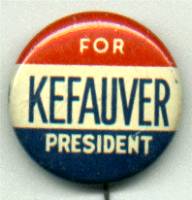Estes Kefauver
Who is Estes Kefauver? What made him tick? How did he situate himself for a run at the presidency in 1952 and 1956?
Well… We start with 3 factoids gathered at an online encyclopedia:
He led a U.S. Senate committee investigating organized crime in 1950 that brought him national attention.
In 1952 he defeated President Harry S Truman in the New Hampshire Primary, but was eventually defeated for the Presidential nomination by governor of Illinois Adlai E. Stevenson.
Although a Southerner, Kefauver was hated by many his fellow Southerners for his liberal position on civil rights and his independence (the Southern Senators usually voted in a bloc).
due no doubt in part to Kefauver’s trademark, a coonskin cap which so effectively connected him with the Davy Crockett craze of the 1950’s.
Support for civil rights probably puts him ahead of Adlai Stevenson… and for that matter, John Kennedy for the 1950s — whose 1960 run for the presidency was considered a rightward shift for the Democratic Party — Eleanore Roosevelt spoke out against him at the DNC Convention.
The much heralded committee investigating organized crime (which, apparently, made legendary “The Mob”… without Kefauver there would be no “Sopranos”) set him up to investigate juvenile crime, which set him up to the more obscure (except in certain, more geeky circles) hearings against comic books — and that lead to the publisher of Archie Comics creating this governing body to punish the publisher of EC Comics… (Note that General Standards B 1 bans the name of the latter company’s best selling titles.) Interesting stuff, I say.
Kefauver: This seems to be a man with a bloody ax holding a woman’s head up which has been severed from her body. Do you think that is in good taste?
Gaines: Yes sir; I do, for the cover of a horror comic. A cover in bad taste, for example, might be defined as holding the head a little higher so that the neck could be seen dripping blood from it and moving the body over a little further so that the neck of the body could be seen to be bloody.
Kefauver: You’ve got blood coming out of her mouth.
Gaines: A little.
Kefauver: This is the July one. It seems to be a man with a woman in a boat and he is choking her to death here with a crowbar. Is that in good taste?
Gaines: I think so.
Beyond that, his political enemies accused him of being a Communist (I wonder if his name was on that list that Joe McCarthy’s waved around):
It was during the Democratic primary campaign in 1948 that Crump attempted to identify Kefauver in the minds of Tennessee voters as a fellow-traveler with communists and liberals by characterizing him as an instrument of unsavory “pinkos and communists” who worked on their behalf like the stealthy, nocturnal raccoon. Kefauver responded in a speech delivered in Crump’s stronghold of Memphis. Pulling on a coonskin cap, Kefauver retorted, “I may be a pet coon, but I’m not Boss Crump’s pet coon.”
And he and Senator Al Gore were staunchly pro – civil rights:
he and his colleague from Tennessee, former U.S. Senator Albert Gore Sr., were the only members of the Senate from the South who categorically refused to sign the so-called Southern Manifesto in 1957, which the reactionary Southern congressional bloc issued in response to the United States Supreme Court’s desegregation decision in Brown v. Board of Education.
So, that’s Estes Kefauver.
He ended Truman’s career. He popularized the Mob. He kept Tennessee from being a majour boiling point in the Civil Rights struggle. And he wore a Davy Crokett Coonskin hat.
Am I missing anything?
